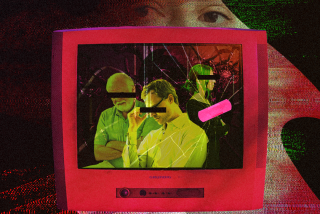Conference Views TV ‘Through the Eyes of Children’
- Share via
NORTH HOLLYWOOD — From a lumpy beanbag set up on center stage, 16-year-old Fairai Richmond put his finger on what he thinks is wrong with children’s television shows.
“You ever notice that all the high schools on TV always look the same?” said Fairai, speaking to a crowd of TV executives and others at the Academy of Television Arts and Sciences on Tuesday.
“You know, not like my high school but some fantasy high school,” said Fairai, who attends Palisades Charter High School in Pacific Palisades. “What kids’ shows need is more reality, you know, they should be more like real life.”
Fairai’s input was exactly what TV industry leaders, including FCC Chairman William Kennard and entertainer Bill Cosby, had gathered to hear. Fairai and a dozen other children talked about which shows they liked and didn’t like, which ones felt real and which ones felt fake, and how TV affects their lives.
The point of the one-day conference, called “Through the Eyes of Children,” was to discuss ways to improve children’s programming, especially in terms of making kids’ TV more diverse. And though a lot of the talk was funny and light, the tone became a little heavier, even that of funny man Cosby, when the subject of racial stereotyping came up.
Children’s shows have a great responsibility to be fair about racial and cultural differences, Cosby said.
“And the whole stereotyping thing is not an accident,” Cosby told the audience. “Industry people wanted the Negro, the African American, the colored man to look the way that he looked, with the nappy hair and big lips, because they thought it was funny. They play the stereotype card because people enjoy it.”
Especially alarming, industry leaders concluded, is the lack of Latino programming. One percent of the roles on TV are Latino characters, and currently there are no English-language shows for Latino children.
“I think that’s a real problem in this country,” said Kennard, the Federal Communications Commission chairman. “More representative TV will help build stronger communities. We need leadership in this area from the industry.”
Executives from Nickelodeon and the Fox Kids Network said they are developing prime-time Latino shows. There was actually a higher percentage of Latino roles on TV in the 1950s than there is now, said Federico Subervi, a communications professor at the University of Texas.
The older experts kept circling back to the need for racially inclusive children’s programs. But some children on the panel--from Lankershim and Victory elementary schools, Pacoima Middle School and Palisades High--said it didn’t really matter.
“I don’t care if shows have people who are black or white, as long as they’re funny,” said Darya Deker, a sixth-grader at Pacoima Middle School. “The point of a really good show is to take your mind off bad things--like homework.”
There’s little doubt of the issue’s importance. Kids ages 6 to 11 watch an average of 2 1/2 hours of TV daily, according to Jon Mandel, managing director of Mediacom, a television advertising firm. Eight percent of those children watch TV after 11 p.m.
A juicy episode of “Dawson’s Creek” will be the talk of the next day at school. If you didn’t see it, no one’s going to bother talking to you, said Chris Mendoza, a senior at Palisades.
Reality-based shows like “When Good Pets Go Bad,” “Busted on the Job,” and the “Jerry Springer Show” were among the programs most frequently watched by children.
Springer, actually, is so popular it has infiltrated high school culture, Chris said.
“As soon as a fight breaks out in the lunchroom, everybody starts yelling, ‘Jerry, Jerry,’ ” Chris said. “It’s kind of funny.”
The problem with kids watching shows like this is that it can stunt social skills, said Gordon Berry, a communications professor at UCLA.
“Children and adolescents go to television to learn how to function in their own lives,” Berry said. “Television is a teacher.”
More to Read
The complete guide to home viewing
Get Screen Gab for everything about the TV shows and streaming movies everyone’s talking about.
You may occasionally receive promotional content from the Los Angeles Times.






